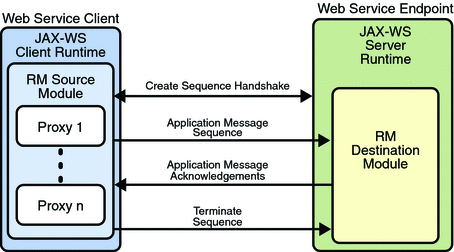How Reliable Messaging Works
When reliable messaging is enabled, messages are grouped into sequences, which are defined by the client’s proxies. Each proxy corresponds to a message sequence, which consists of all of the request messages for that proxy. Each message contains a sequence header. The header includes a sequence identifier that identifies the sequence and a unique message number that indicates the order of the message in the sequence. The web service endpoint uses the sequence header information to group the messages and, if the Ordered Delivery option is selected, to process them in the proper order. Additionally, if secure conversation is enabled, each message sequence is assigned its own security context token. The security context token is used to sign the handshake messages that initialize communication between two web service endpoints and subsequent application messages.
Thus, using the Reliable Messaging technology, web service endpoints collaborate to determine which messages in a particular application message sequence arrived at the destination endpoint and which messages require resending. The reliable messaging protocol requires that the destination endpoint return message-receipt acknowledgements that include the sequence identifier and the message number of each message received. If the source determines that a message was not received by the destination, it resends the message and requests an acknowledgement. Once the source has sent all messages for a given sequence and their receipt has been acknowledged by the destination, the source terminates the sequence.
The web service destination endpoint in turn sends the application messages along to the application. If ordered delivery is configured (optional), the destination endpoint reconstructs a complete stream of messages for each sequence in the exact order in which the messages were sent and sends them along to the destination application. Thus, through the use of the reliable messaging protocol, the destination endpoint is able to provide the following delivery assurances to the web service application:
-
Each message is delivered to the destination application at least once.
-
Each message is delivered to the destination application at most once.
-
Sequences of messages are grouped by sequence identifiers and delivered to the destination application in the order defined by the message numbers.
Figure 2–7 shows a simplified view of client and web service application message exchanges when the Reliable Messaging protocol is not used.
Figure 2–7 Application Message Exchange Without Reliable Messaging

When the Reliable Messaging protocol is not used, application messages flow over the HTTP connection with no delivery assurances. If messages are lost in transit or delivered out of order, the communicating endpoints have no way of knowing.
Figure 2–8 shows a simplified view of client and web service application message exchanges when reliable messaging is enabled.
Figure 2–8 Application Message Exchange with Reliable Messaging Enabled

With reliable messaging enabled, the Reliable Messaging source module is plugged into the JAX-WS web service client. The source module transmits the application messages and keeps copies of the messages until their receipt is acknowledged by the destination module through the exchange of protocol messages. The destination module acknowledges messages and optionally buffers them for ordered-delivery guarantee. After guaranteeing order, if configured, the destination module allows the messages to proceed through the JAX-WS dispatch for delivery to the endpoint or application destination.
- © 2010, Oracle Corporation and/or its affiliates
